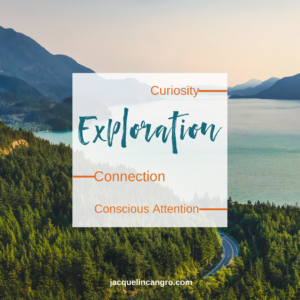The best writing prompts foster curiosity, connection, and conscious attention. These writing prompts, I call them explorations, are grounded in your world, based on what you notice, what you find interesting and exciting enough to record. (You know how I feel about generic writing prompts.) Explorations may be the genesis for a new story or aid in character development. Or you may find bits showing up in scenes, lending more vibrant details that make your prose feel authentic.
Seeking Color
Color affects our mood. It is used in healing and therapy. It has different symbolic meanings in different cultures. We gravitate toward certain colors and shy away from others. Everything around us has a color and we’re often assigning value to it based on the color.
Try this exploration by finding objects of the same color:
1.Select a color. It can be a color you love or one you love to hate. It can be a shade of a color (lime green or salmon anyone?). I’m selecting blue.
Challenge yourself. Choosing white or black would certainly require you to be even more observant since these colors are ubiquitous!
2. Grab your notebook and your phone. During your daily routine, look for your color and document it. If you see a bright orange Mini Cooper, make a few notes. Where and when did you notice it? What was happening around it? Did the color interplay with other colors around it? Written notes are excellent at capturing what you notice in the moment and a photo is a great way to pick up on something you missed later. Both help me fuel my stories as touch points for interesting ways to expand a scene or character.
Post your photos on Instagram with #colorexploration. Let’s share our inspiration and exploration.
Challenge yourself. Your color doesn’t have to show up in large splashes. It can be on a jelly bean or a child’s hair clip.
3. Connect your impressions. Colors and what they represent can bring up a lot of memories. Make a note of any memories and feelings associated with your color. This is an important step because connecting your emotions to your experience is something that will inform your writing. For example, the foundation of good characterization is specificity. Characters that have specific reactions to their surroundings based on their emotions connect us to them. They’re not just dropped into this world you’ve created; they’re reacting to it. And you can practice this by making the connection in your world.
Challenge yourself. If you already have a story in progress, put your character in your shoes. What would he or she notice about this color, this object or this situation?
Most importantly, have fun with this!
Come follow my progress on Instagram where I’ll be posting all of the interesting shades of blue I find during the week. #colorexploration
Need some support to stay on track with your story this summer? My 1:1 writing coaching will help keep you engaged and moving forward. I’ve put together a special summer program. Come Labor Day, you’ll make a smooth transition back into your regular routine. More information can be found here.



